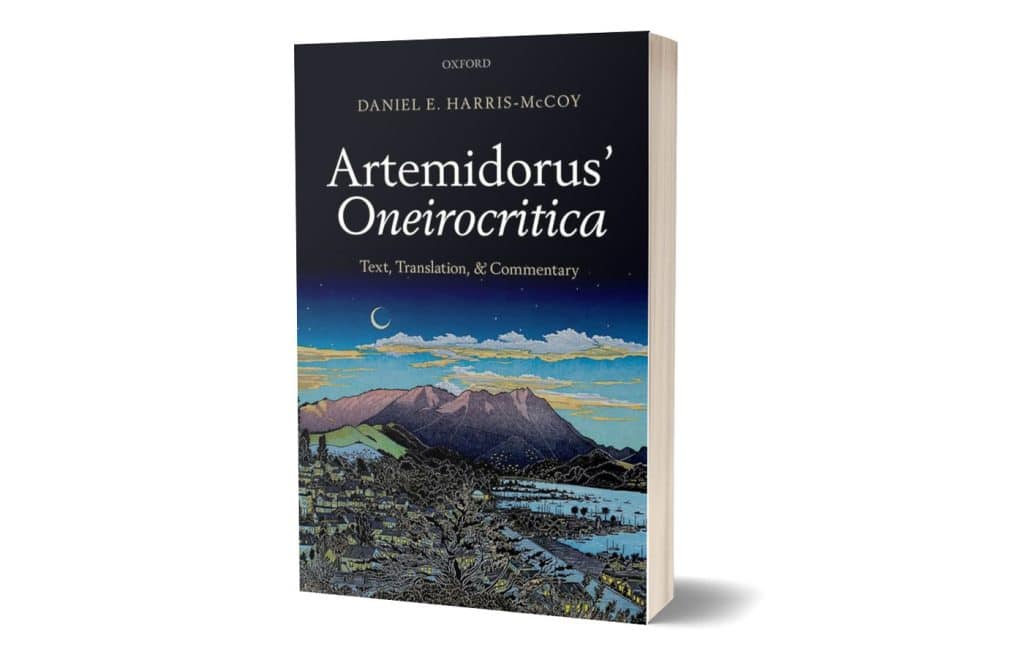“Oneirocritica,” also known as “The Interpretation of Dreams,” is a monumental work by Artemidorus of Daldis, a Greek dream expert from the 2nd century AD. It is one of the oldest and most influential works dedicated to the analysis and interpretation of dreams that has been preserved to our times.
Consisting of five books, “Oneirocritica” systematically classifies dreams and offers guidelines for their interpretation, based on a rich collection of over three thousand dream examples. This work not only provides invaluable insight into ancient beliefs and practices related to dreams but also highlights the universality and significance of dreams in human life.
Who was Artemidorus?

Artemidorus of Daldis, who lived in the 2nd century AD, was an ancient Greek philosopher. He was born in Ephesus but came from Daldis in Lydia.
Artemidorus lived during the times of Roman dominance over the Greek world, when various cultures and beliefs collided and intermingled with each other. His work, written in Greek, reflects a wide range of influences – from Greek philosophy to oriental dream interpretation practices. “Oneirocritica” is a product of an era in which magic, religion, and the beginnings of a scientific approach to natural phenomena and human psyche coexisted without clear boundaries.
Dream Categories
“Oneirocritica” divides dreams into two main categories: those that predict the future in a literal manner (oneiromancy) and those that require symbolic interpretation (oneirocritica). Artemidorus meticulously describes various types of dreams, from those bringing good news, to warning or even ominous ones. Each dream is carefully analyzed, taking into account the life context of the dreamer, which makes the interpretation of the dream unique and individual.
Artemidorus’s work emphasizes the importance of dreams as a form of communication between divinity and humans, as well as a tool for self-knowledge and predicting the future. The author notes the connection between the psychological and physical state of the dreamer and the content of the dream, indicating his intuition about the complexity of the human mind.
The books of “Oneirocritica” by Artemidorus of Daldis constitute a work divided into five volumes, each discussing different aspects and methods of dream interpretation, forming a comprehensive compendium of knowledge on the subject. The first three books focus on the categorization and analysis of various groups of dreams, considering them from the perspective of human body anatomy, objects and events in the natural world, and a variety of mixed themes.

Book One
The first book is dedicated to the anatomy and activities of the human body, breaking down into 82 sections the interpretations of motifs appearing in dreams, such as the size of the head, eating, or sexual activity. For example, section 52 discusses one of the body’s activities: “All instruments that cut and divide things in half signify discord, factions, and injuries… Instruments that smooth surfaces foretell the end of hostilities.”
The entirety of the first book can be seen here: Βιβλίον αʹ
Artemidorus begins by explaining his initial hesitations about undertaking the discussed subject, which arose not from laziness or lack of courage but from concerns over the magnitude and complexity of the issues, as well as the controversies it might provoke in others. He is motivated to work by current needs, both his own and those of future generations. He emphasizes his experience and knowledge of the subject, gained through travels and conversations with various people, which allowed him to accumulate knowledge about dreams and their interpretations.
He then moves to the main part of the text, where he deals with the differences between dreams and dream visions, pointing out their distinct characters and functions. He emphasizes that dreams can be significant and predict the future, thus becoming an important element in people’s lives and decisions. He distinguishes two main types of dreams: theoretical, which are literal and direct, and allegorical, requiring interpretation. Artemidorus aims to explain the reasons why people have such dreams and the meanings of names associated with dreams, trying to provide a general definition of a dream as a psychic phenomenon with prophetic significance.
In the further part of the text, detailed descriptions of different types of dreams and their meanings are presented, including dreams concerning both specific individuals and those with broader social or cosmic significance. Artemidorus also discusses cases when dreams do not come true, which can result from various reasons, such as the lack of proper interpretation or improper action by the dreamer. The text concludes with a reflection on the role of dreams in people’s lives, their potential in predicting the future, and ways of their interpretation, emphasizing the importance of experience and knowledge in this process.
Book Two
The second book deals with objects and events in the natural world, such as weather, animals, gods, and flying. The section dedicated to animals covers mammals (domestic and wild), sea creatures, reptiles, and those that fly. Therefore, in chapter 12, we find: “There exists a kinship between all wild animals and our enemies. The wolf signifies a violent enemy… The fox indicates that the enemy will not attack openly but will scheme deceitfully.”
Book Two: Βιβλίον βʹ
Artemidorus’s second book focuses on more detailed interpretations of dreams related to everyday activities and objects, expanding the knowledge presented in the first book. Artemidorus continues his explorations of dream meanings, delving into topics such as the appearance and condition of clothing, interactions with various objects and natural phenomena, and the impact of these dreams on daily life and individual decisions. The author elaborates on how different aspects of dreams, such as seeing clear air, struggling with various weather conditions, interactions with jewelry, and events like lightning or seeing fire, can carry significant messages for the dreamer. Artemidorus emphasizes understanding the context of the dream and the individual circumstances of the dreaming person, highlighting the complexity of dream interpretations and their potential impact on future actions and life decisions. This work also underscores the importance of dreams in ancient culture and beliefs, offering insight into how ancient people attempted to understand and utilize dreams to predict and shape their future.

Book Three
The third book has a mixed character and covers a wide range of topics not classified in the first two parts. It is a classic text on dream interpretation, in which Artemidor delves into the meanings of various dreams and their symbolism, trying to distinguish those that predict the future from those without significance.
Book Three: Βιβλίον γʹ
Artemidorus’s third book provides further interpretations of dreams, focusing on various situations and objects that may appear in dreams. Artemidorus continues his methodical analysis, examining the significance of dreams related to different aspects of everyday life and the natural world. This book expands the understanding of dreams presented in previous volumes, adding detailed explanations and new interpretative categories. Through this work, Artemidorus aims to provide readers with a comprehensive guide to the meanings of dreams, reflecting the beliefs and cultural practices of his times.
Book Four
In the fourth book, Artemidorus moves from the content of dreams to the techniques of their interpretation, addressing it to his son. He emphasizes that the interpreter must know the background of the dreamer, such as his occupation, health, status, habits, and age. The likelihood of the dream’s content should also be considered, which is not possible without reference to the dreamer. The interpreter should find out how the dreamer feels about each component of the dream.
Book Four: Βιβλίον δʹ
In the fourth book, Artemidorus continues his in-depth and systematic studies on dreams, emphasizing the importance of correct dream interpretation and their impact on people’s daily lives. In this volume, he particularly focuses on the diversity of dreams and their specific meanings, depending on the life context of the dreamer and the particular content of the dream. Artemidorus categorizes dreams into theoretical (literal) and allegorical (requiring interpretation), then discusses various categories of dreams in detail, paying attention to their potential messages and impact on the future.
The author highlights the importance of dreams in various aspects of life, from personal experiences to larger social or natural events. He also notes that not all dreams are equally important or worthy of interpretation, pointing out differences between mere dream visions and prophetic dreams. Artemidorus explains how certain dreams can symbolize events or changes in the personal life of the dreamer, offering guidance on how to distinguish which dreams carry significant messages and which should be ignored.
Book Five

In the fifth book, Artemidorus presents another 95 dreams that he has collected, so his son can use them as exercise material.
Book Five: Βιβλίον εʹ
The fifth book of Artemidorus’s work, like the previous ones, focuses on the interpretation of dreams but assumes a slightly different form. The author directly addresses his son, explaining the reasons for the delay in working on the book, which stem not from laziness but from the difficulty of gathering noteworthy dream visions that require time and effort to understand and document. He stresses that while it is easy to collect common dreams, finding those unique ones that deserve attention and can be a source of pride for the author requires much more work. Artemidorus explains that he traveled across Greece, Asia, and Italy to collect dreams that could be useful both for him and for others interested in dream interpretation.
Artemidorus then presents a series of dream interpretations that relate to various aspects of life and human activity, such as social status, health, professional activity, or family relationships. Each dream is analyzed individually, considering specific circumstances and potential meanings. The author explains how to interpret dreams involving individual objects, animals, gods, and other elements, providing examples that may indicate upcoming events, warn of dangers, or foretell changes in the life of the dreamer.
The fifth book demonstrates Artemidorus’s deep knowledge of the subject and his commitment to providing readers with practical tools for interpreting their own dreams. Through his work, Artemidorus seeks to prove that dreams have meaning and can offer valuable insights into the future, health, and even hidden desires and fears. This book is also a testament to the ancient fascination with dreams and belief in their prophetic power.
Popular Symbols
Here are selected symbols and their interpretations according to “Oneirocritica”:
- Water – Water often symbolizes emotions, intuition, and changes in the life of the dreamer. Its condition (calm, turbulent) can indicate the emotional state of the person dreaming or impending changes.
- Animals – The appearance of animals in dreams can have various meanings, depending on the species and the context of the dream. For example, snakes can symbolize wisdom, rebirth, temptation, or betrayal, while horses may represent strength, passion, or sexuality.
- Death – Although it may seem alarming, death in dreams often symbolizes the end of a certain phase in life and the beginning of a new chapter, transformation, or the need for change.
- Flying – Dreams about flying may reflect a desire for freedom, escape from problems, ambitions, and control over one’s life and decisions.
- Falling – May symbolize fear of failure, loss of control over some aspect of life, or something that is ending in the dreamer’s life.
- Exam – Dreams about exams often relate to stress, fear of judgment, and anxiety about not meeting expectations – both one’s own and those of others.
- Gold – In dreams, gold can represent the pursuit of wealth, success, and the search for inner value or truth.
- House – A house in dreams often refers to the dreamer themselves – their psyche, soul, and current emotional state. Individual rooms can symbolize different aspects of personality or life.
- Journey – Traveling in dreams can symbolize the life path of the dreamer, their personal development, transformations, and the search for purpose or meaning in life.
- Fire – Fire can have both positive and negative meanings, depending on the context of the dream. It may symbolize passion, renewal, transformation, or destruction.
Influence and Significance
“Oneirocritica” has inspired scholars, philosophers, and artists over the centuries, becoming a foundation for later studies on dreams. This work was known throughout the ancient and medieval world, translated into many languages, and its influence even reached Renaissance and modern studies on the human psyche.
The influence of Artemidorus is clearly visible in later dream theories, including the work of Sigmund Freud, who recognized “Oneirocritica” as an important reference in his pioneering research on the unconscious. Although contemporary approaches to dream interpretation may differ from Artemidorus’s methods, his work remains an invaluable source of knowledge on the history and evolution of human beliefs related to dreams.
Oneirocritica online
Read online book – openlibrary.org
Video
Bibliography
- Artemidorus of Daldis. „Oneirocritica (The Interpretation of Dreams).” Translated by Robert J. White. Park Ridge: Noyes Press, 1975.
- Artemidorus. „The Interpretation of Dreams: Oneirocritica.” Translated by Robert L. Van De Castle. New York: BRILL, 1990.
- Harris-McCoy, Daniel. „Artemidorus’ Oneirocritica: Text, Translation, and Commentary.” Oxford: Oxford University Press, 2012.
- Price, Simon. „Religions of the Ancient Greeks.” Cambridge: Cambridge University Press, 1999.
- White, R. Gordon. „Dreams and Dreaming in the Roman Empire: Cultural Memory and Imagination.” London: Bloomsbury Academic, 2013.





